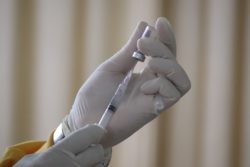Leuprolide, more commonly known as Lupron, is promoted within the gynecological field as one of the best options for treating endometriosis. Lupron is also used for men with prostate cancer and children going through precocious puberty. Endometriosis is a secondary autoimmune disease where the lining of the uterus (the endometrium) grows outside of the uterus, breaking down and bleeding in conjunction with a woman’s regular menstrual cycle. The displaced endometrium, having no way of leaving the body causes scarring, cysts, internal bleeding, chronic pain and infertility. There is currently no cure for endometriosis. Current treatments include laproscopic surgery, oral contraceptives, partial or complete hysterectomy and GnRH agonists such as Lupron.
What is Lupron?
Lupron in a GnRH agonist which puts the female into a chemically induced state of menopause and is often associated with serious side-effects. According to Dr. David Redwine, a gynecologist with over 30 years of experience treating endometriosis, “The state of menopause with Lupron is very unnatural, not only because it is chemically induced with medicines, but because FSH levels are not elevated as they are in normal menopause. Lupron temporarily stops menstruation but does nothing to eradicate endometriosis from the woman’s body.” What Lupron does do is suppress the body’s pituitary-gonadal system potentially causing an onslaught of endocrine, neural and immune side-effects.
Side Effects
While this list is not all inclusive, it does however, include many of the more commonly reported side effects of Lupron:
- fatigue
- hot flashes
- depression
- insomnia
- joint pain
- decreased bone density
- loss of sex drive
- vaginal dryness
- loss of appetite
- weight gain
- nausea
- changes in bowel patterns
- acne
- facial hair growth
- increased body hair growth
- breakthrough bleeding
- dizziness
- night sweats
- chills
- muscle pain
- overall feeling of physical weakness
- stomach pain
- constipation
- diarrhea
- vaginal itching and/or discharge
- breast swelling or tenderness
- memory problems
- changes in urinary control
- skin redness and itching
- headaches
- blurred vision
- diabetes
- convulsions
- hair loss
- anemia
- fibromyalgia like symptoms
- hyperglycemia
- ECG changes
The Lupron and Endometriosis Connection
Given the general lack of knowledge and sparsity of endometriosis specialists – it almost makes sense that a drug that stops menstruation and induces a hormonal standstill, would be effective in treating endometriosis – almost. However, Lupron does not cure endometriosis nor does it effectively treat endometriosis. What it does cause is a host of painful side effects which can last long after the drug’s maximum 6 month dosage.
As a co-founder of Endo Warriors, a support group for women with endometriosis, I have spoken to countless women with endometriosis who have been prescribed Lupron for their endometriosis. Of these women, I have never heard one say that taking Lupron either helped their symptoms or provided any decreased endometriosis progression. Instead I have heard several stories of women developing thyroid disease, women experiencing hot flashes and breakthrough bleeding as painful as if they were menstruating, women in their late twenties coming off Lupron with bone densities resembling those of women in their late sixties, and stories of developing fibromyalgia and chronic fatigue.
Despite the adverse consequences of Lupron being known within the Lupron-prescribed portion of the endometriosis community, the dissemination of that knowledge generally stops there. In fact, there are plenty of websites that describe endometriosis as a common and treatable reproductive disease – going on to cite Lupron as not only an effective but an optimal treatment. While endometriosis is indeed common, with 176 million sufferers worldwide, it is not easily treatable. And unfortunately, none of those 176 million women will see a cure until some honest dialogue take places regarding the challenges in treating endometriosis and credible evidence regarding the safety and efficacy of Lupron and other prescribed treatments for endometriosis is available.
Lupron Side Effects Survey
To determine the rate, range and scope of side-effects associated with Lupron use in women’s health, Lucine and Hormones Matter are conducting an online survey: The Lupron Side Effects Survey. The survey is anonymous and takes only 15 minutes to complete. If you are woman who has ever been prescribed Lupron, please take a few minutes to complete the survey. Your data will give other women the information they need to make a decision about Lupron.











